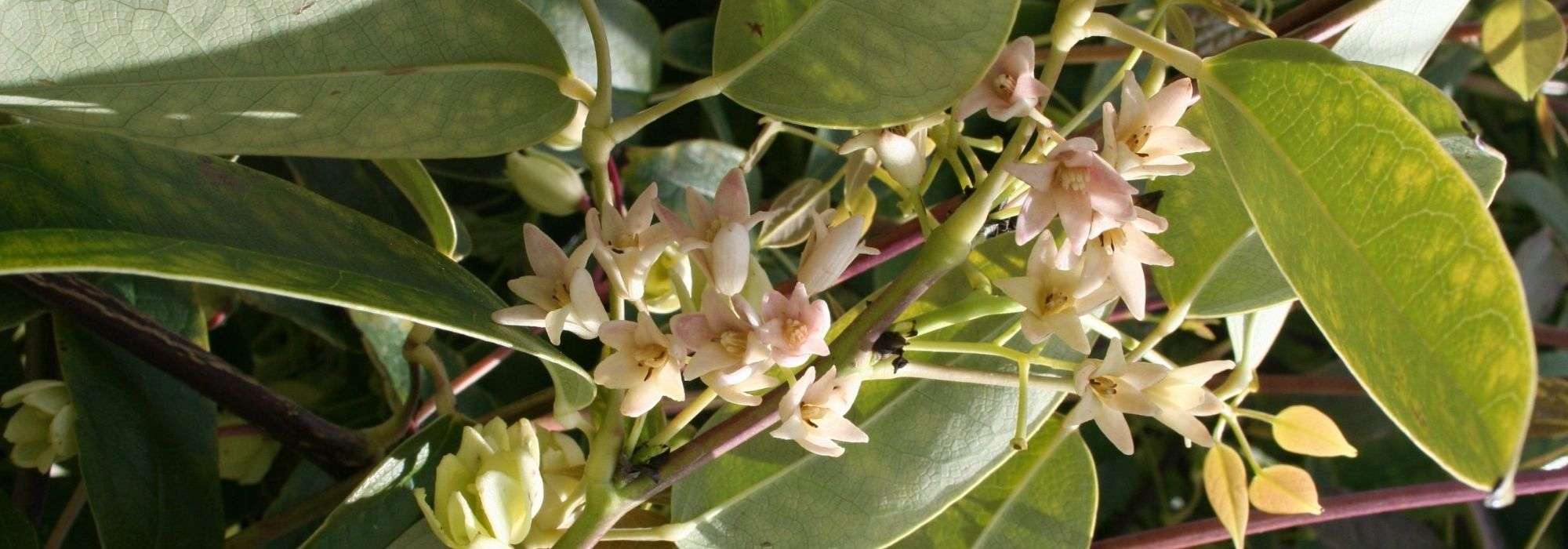
Holboellia (sausage vine): planting, growing, care
Contents
Holboellia in a nutshell
- Holboellia is a vigorous climbing plant with evergreen foliage, decorative all year round.
- Its spring flowering, featuring fragrant bell-shaped flowers, is followed by unique and edible fruits.
- Of medium hardiness, it is easy to grow in any soil that is not too chalky.
- It can be used in the ground as well as in pots.
- Resistant to diseases, it thrives in sunny or partially shaded locations.
The word from our expert
Holboellia, also known as sausage vine, is an exuberant climbing plant from Asia, closely related to Akebia. With vigorous growth, it is valued for its green, evergreen foliage but especially for its spring flowering, featuring fragrant bell-shaped flowers in cream tones, tinged with yellow or purple.
In late season, the plant produces edible purplish fruits, reminiscent of pear flavours, although their taste appeal is somewhat limited. While it produces both male and female flowers, two plants are necessary for effective pollination and fruit production.
A liana that wraps itself around its support, Holboellia is a plant that thrives in rich, humus-bearing soils, low in lime, with sunny (but not scorching) to semi-shaded exposures.
Well resistant to diseases, Holboellia has limited hardiness, but it is well-suited for cultivation in pots.
Its cultivation and maintenance are not difficult, and its qualities make it an excellent candidate for covering walls, arbors, or pergolas.
Description and botany
Holboellia is a vigorous climbing plant native to Southeast Asia, primarily near the Himalayas, from India to China. It grows spontaneously in mixed forests and along the cool banks of waterways, from 600 m to 3000 m in altitude. It belongs to the family Lardizabalaceae, along with its close relatives such as Akebia and Stauntonia. Among the various species, the most commonly cultivated are Holboellia latifolia and Holboellia coriacea (also known as ‘Chinese Blue Vine’ due to the colour of its fruits).
This climbing plant is voluble and wraps around its support, which must be sturdy enough to support its relatively significant growth. Holboellia can easily reach 5 m in height and 2 m in width on average, but its flowering may take 2 to 3 years to appear. It is therefore not advisable to plant it at the base of small or young bushes, as it may suffocate them.
Its evergreen foliage is dark green and leathery. The leaf, measuring 7 to 15 cm long, is described as odd-pinnate, meaning it is actually composed of several elliptical and independent leaflets, in an odd number (including one terminal leaflet), inserted on either side of the petiole. The number of leaflets can vary from 3 to 9, and their edges are entire.
While the foliage is less graphic than that of Akebia, the flowering of Holboellia is pleasantly fragrant and emits citrus notes, sometimes enhanced by melon and jasmine. It occurs in spring, between March and May, in the form of corymbiform racemes (clusters) about ten centimetres long.
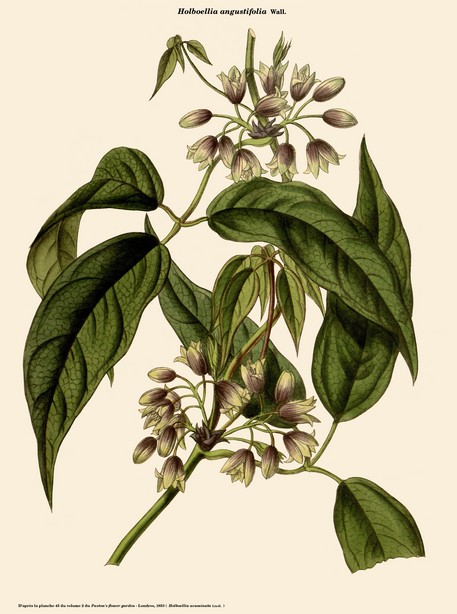
Holboellia angustifolia – botanical illustration
This climbing plant bears flowers that are campanulate, meaning bell-shaped. The colours can vary from pure white to cream, and display more or less yellow, pink, or purple hues. Monoecious, Holboellia has both male and female flowers on the same plant. The male flowers bloom in pendulous clusters at the tips of one-year-old branches. The female flowers, on the other hand, appear at the base of new shoots. Some gardeners have noted that the colours of the flowers can differ between male and female flowers. It is the narrow, fleshy sepals, numbering 6, that catch the eye. The inflorescences are generally cream, tinged with pink, purple, or yellow.
In autumn, indehiscent fruits (which do not open at maturity) adorn the plant. They are purple to violet and contain pulp that holds the seeds. Oblong in shape and measuring 5 to 10 cm long, these curious fruits have earned this climbing plant its English name of ‘Sausage vine‘.
While their flesh, which has a flavour reminiscent of pear, is edible, it is not particularly interesting in taste, and only a sufficiently warm climate allows the fruits to ripen.
With average hardiness (-10°C), Holboellia is particularly sensitive to spring frosts, which can harm its flowering, especially since the plant buds early in the season. It is also wiser to protect it from cold winds as well as prolonged frost.
Well resistant to diseases, it is a climbing plant easy to cultivate in any relatively humus-bearing and rich soil, well-drained and not too calcareous. It prefers partial to full sun exposure, but its foliage may suffer or scorch in scorching locations.
Although flowers of both sexes are present on the plant, it is preferable to install two genetically different plants to encourage fruiting.
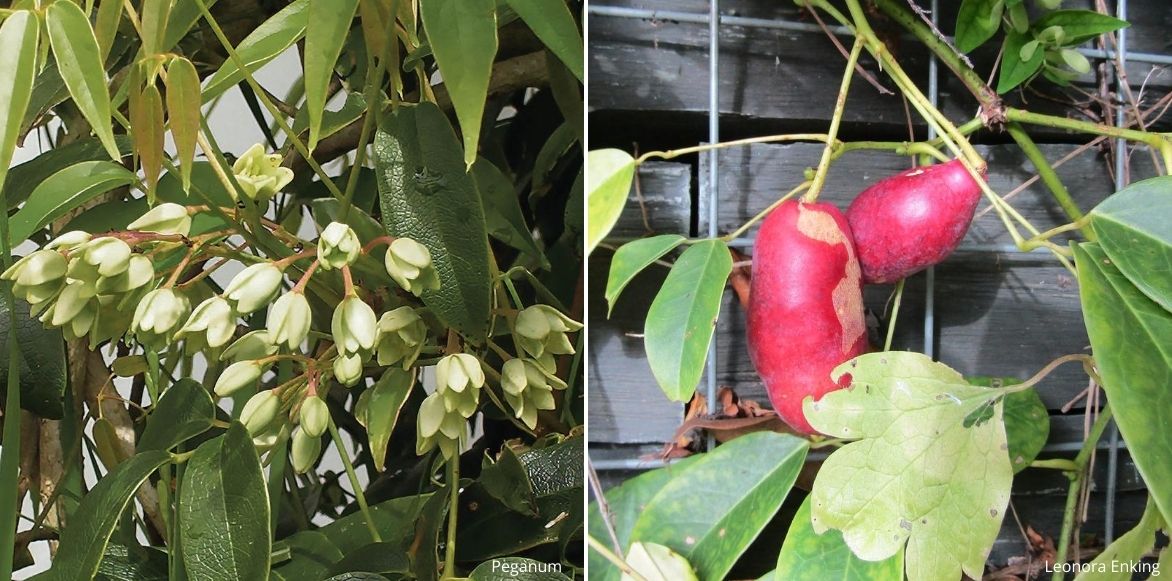
Flowers of Holboellia coriacea and characteristic fruits of Holboellia angustifolia
Growing at a normal to relatively fast rate, Holboellia is suitable for both open ground and pot cultivation on a terrace, in a suitably sized container.
The different varieties
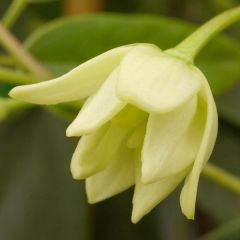
Holboellia latifolia - Broad-leaved Sausage Vine
- Flowering time April, May
- Height at maturity 5 m
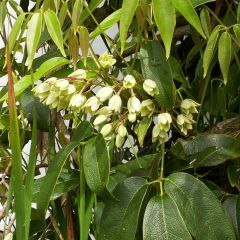
Holboellia coriacea - Sausage Vine
- Flowering time May, June
- Height at maturity 5 m
Discover other Holboellia
View all →Available in 1 sizes
Available in 1 sizes
Available in 1 sizes
Available in 1 sizes
Available in 1 sizes
Planting Holboellia
Where to plant?
- Plant Holboellia in soil that is rich in organic matter and fairly fertile. The drainage should prevent the roots from sitting in constantly wet soil, especially in winter. While this climbing plant can tolerate some limestone, avoid overly alkaline soil.
- Choose a sunny but not scorching location, sheltered from drafts.
- Avoid walls facing East to prevent young flower buds from being subjected to harsh frosts and thaws caused by this exposure.
- In very cold climates, grow Holboellia in a pot, which you can move to a sheltered spot during the bad season.
- To keep the soil cool and provide frost protection, ensure the base is always well mulched.
When to plant?
The ideal planting time is autumn, ensuring good rooting before the bad season. Spring planting is also quite possible, and even recommended in regions with harsh winters. This allows the plant to settle in well before the next cold season.
How to plant?
Planting in the ground
- Soak the root ball in a large volume of water until the substrate is saturated.
- Using a spade, dig a hole at least twice the size of the root ball in all directions.
- In heavy soil, add 4 to 5 cm of drainage at the bottom of the hole, such as gravel.
- Improve the soil by adding a suitable amendment, such as well-matured compost (about 2 or 3 handfuls mixed with the extracted soil). In heavy, compact soil, add 1/3 coarse sand to improve water drainage.
- Start by filling the hole with your mixture, then position the root ball so that its top is level with the soil surface.
- Fill in with the remaining mixture.
- Lightly compact with your foot, then water thoroughly, even if it is raining.
- Apply a mulch 5 to 10 cm thick. There is a wide choice of mulch, whether organic or mineral.
- Ensure to guide the stems onto their support, and feel free to assist their attachment with soft ties initially.
Planting in a pot
- Soak the root ball to saturate it with water.
- Place a layer of drainage at the bottom of the pot (gravel, clay balls, etc.) about 5 cm thick.
- Pour rich, good-quality potting soil into a suitably sized pot (minimum 50cm x 50cm).
- Remove the root ball from its pot and place it in the centre, ensuring its top is about 2 cm from the rim.
- Fill in with the same potting soil just to cover the root ball, and compact.
- Water thoroughly, and in several stages if necessary.
- Apply mulch with your chosen material.
- Guide the first branches onto their support.
Read also
10 climbing plants for mild climatesCare
Holboellia requires little maintenance. Especially in the first few weeks or months (depending on the weather), make sure to keep the substrate moist and prevent it from drying out. If you’re not quite confident with watering, check out all our tips for watering like a pro!
Ensure that the base is adequately mulched, and regularly top up if using organic mulch, which naturally decomposes.
Pruning Holboellia
Pruning helps maintain a harmonious architecture and a compact habit, control the plant’s expansion, and encourage generous flowering.
Maintenance pruning
Prune after flowering, cutting back the branches by one third (or more if the plant has become too large).
Renewal pruning
For older specimens, it is possible to remove old branches to encourage the plant to produce new vigorous shoots. However, do not prune more than one third of these branches each year (this way, you can completely rejuvenate your climbing plant in 3 years).
Multiplying Holboellia
Propagation by sowing
Multiplying Holboellia by sowing works very well.
- Sow mature, fresh seeds in spring, in a seed tray filled with light compost.
- Cover with sifted compost or fine gravel to a depth approximately equal to that of the seeds, then lightly press down to ensure good contact between the seeds and the substrate.
- Soak the seed tray in water until the compost is evenly moist (or water very gently to avoid displacing the seedlings).
- Place in a bright location but out of direct sunlight, at an ideal temperature between 15°C and 20°C.
- Ensure the compost does not dry out. Germination may take 2 to 3 months.
- When the young plants have 2 true leaves, transplant them into individual pots.
- Plant your young plants in their final location, after ensuring that the plant has developed a sufficient root system.
Propagation by cuttings
Propagation by cuttings is preferably done from late summer to early autumn.
- Select healthy, semi-ripe branches, meaning not yet fully lignified but not soft.
- Cut sections of stems starting from a node (the part where the secondary stem inserts onto the main one) up to just above the next bud on the stem to be taken.
- Remove the side leaves, but keep a few at the top.
- Insert the prepared cuttings into a deep pot filled with light compost. You may dip the base of your cuttings in plant hormone beforehand to encourage root development.
- Thoroughly moisten the compost, and cover with transparent plastic, ensuring it does not touch the leaves.
- Place in a bright location, but out of direct sunlight.
- Monitor the compost to ensure it does not dry out.
- Once the new roots are well developed, transplant into a slightly larger pot or into the ground (depending on the season and your climate).
Pairing ideas with Holboellia
Complete the flowering of Holboellia with other climbing plants, such as clematis for example (be sure to check the flowering and pruning periods specific to each group to facilitate the maintenance of this association), an ivy or a virginia creeper. A simple and effective alternative is to use easy and fast-growing annual climbers, which will use your Holboellia as support for the season.
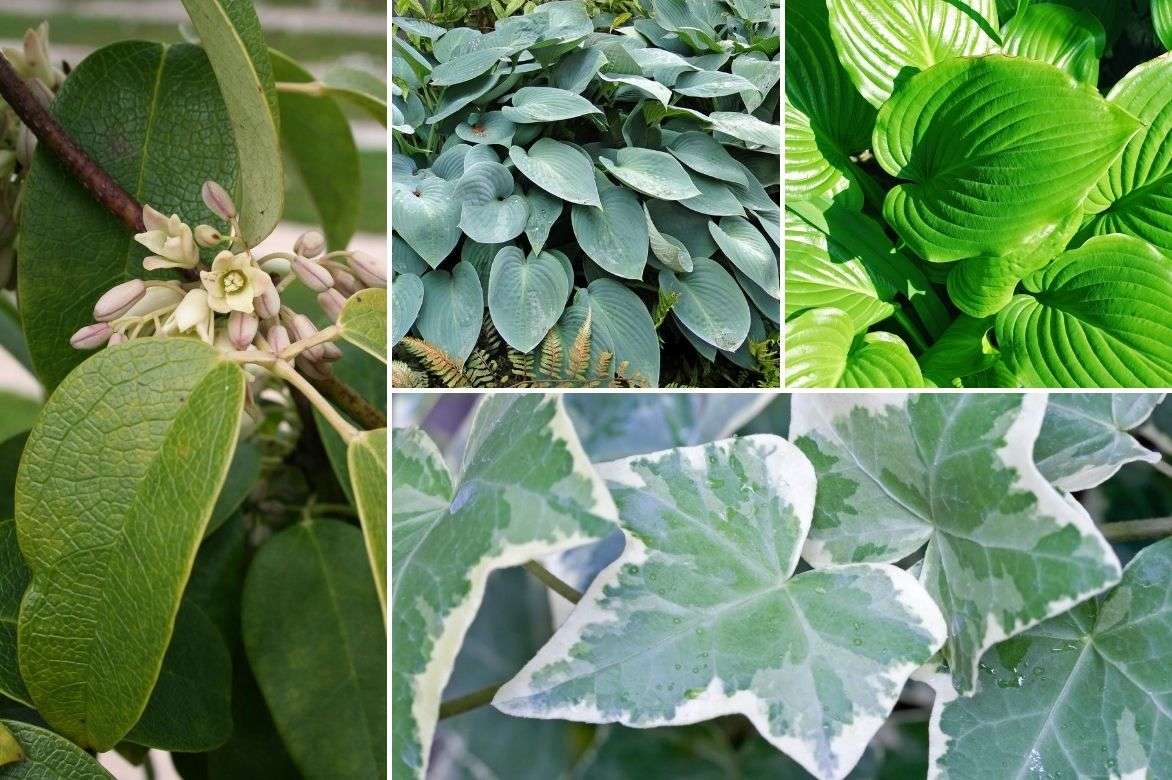
An example of an association in partial shade: Holboellia coriacea and variegated ivy on the facade of a building, along with a display of Hostas in different shades at their base. Why not also add some ferns with lovely dissected foliage or hardy geraniums?
When it comes to shrubs, you can play with the timing of flowering with Pieris (with campanulate flowers), Leucothoe, or Loropetalum (often with colourful foliage). Alternatively, you might prefer to add colour once the flowering of your Holboellia is finished, by turning to Chinese azaleas, Hydrangeas, or a Daphne with continuous and fragrant flowering throughout the summer.
Among perennials, the choice is vast with Achilleas, Foxgloves, or hardy geraniums, not to mention the campanulas, whose bells echo those of your climber. At the base of the Holboellia, you can plant decorative foliage plants like Hostas as well.
The grasses, which are very easy to grow, bring a lot of lightness and often beautiful colours in autumn.
At the base of your composition, install some early flowering bulbs (Daffodils, Tulips, Crocuses…) to welcome the season with cheer.
→ Discover more association ideas with Holboellia in Sophie’s article.
Useful resources
- Discover our selection of Holboellias.
- Find our tips for growing Holboellia in pots.
- Subscribe!
- Contents
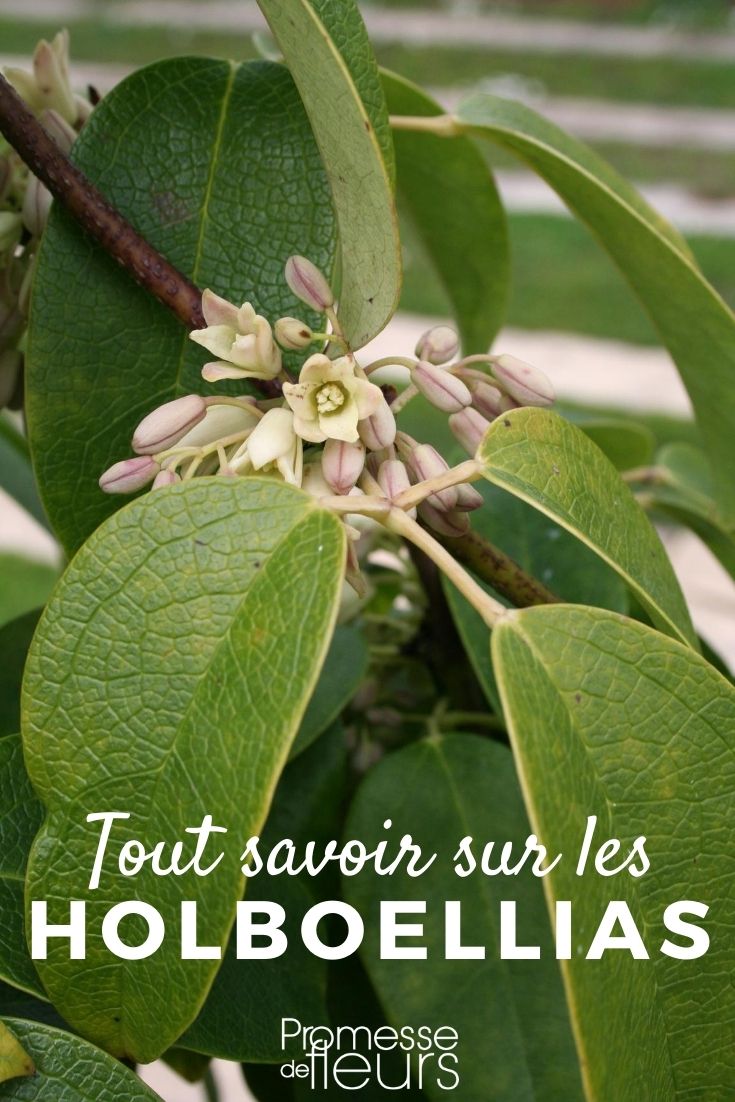


































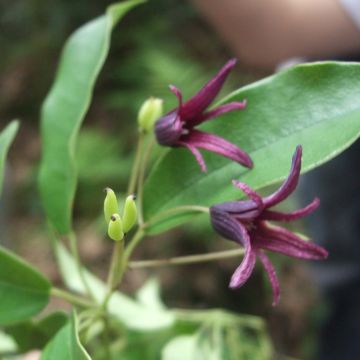
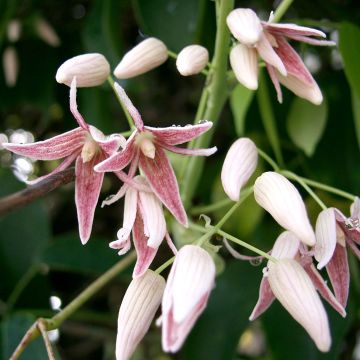
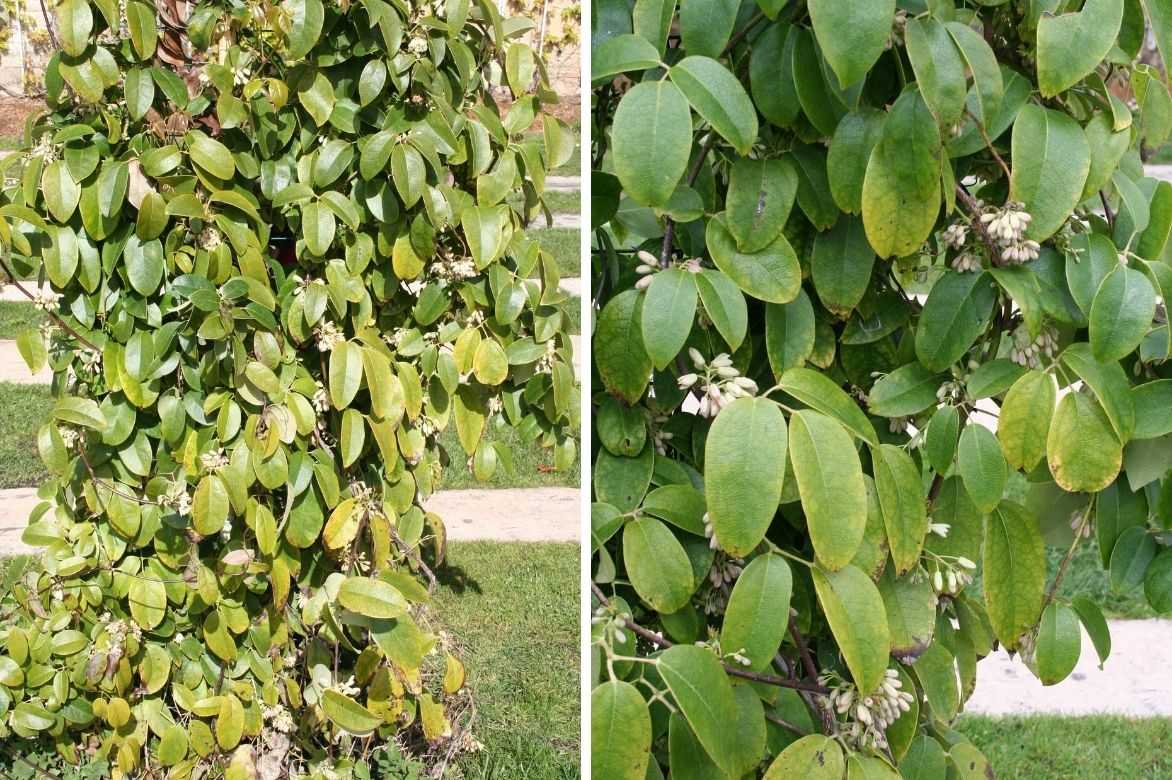
Comments